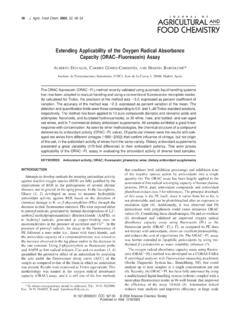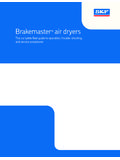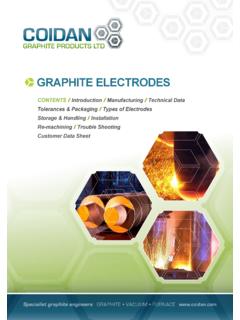Transcription of Refractometer Calibration, Use and Maintenance
1 University of California Cooperative Extension Fresno County Harvest season will soon be upon us in the San Joaquin Val-ley, which means that testing fruit for maturity will become a daily task. Proper sampling for sugar is important for making decisions on harvesting specific varieties or locations. Often referred to as soluble solids or sugar test-ing, fruit maturity evaluation in-volves sample collection and test-ing procedures that accurately represent the crop. Testing for sugar content in fruit has become easier as technology has im-proved. However, improved tech-nology cannot eliminate deficien-cies in sample collection or errors caused by poor Refractometer care and Maintenance .
2 Reviewing the following tips should improve the accuracy and utility of sugar data in determining fruit maturity. Choosing and Using a Handheld Refractometer There are two types of hand-held refractometers: analog and digital (Fig. 1). They work on the principle that light entering a prism has a unique characteristic. That characteristic is represented by a value on a scale in units known as Brix. When light enters a dry prism, the field of view in an analog Refractometer remains blue (Fig. 2). In a digital refracto-meter, an error message would appear. Both are indications that the light is not being interfered with as it passes through the prism.
3 Pure water placed on the re-fractometer should result in a reading of zero (Fig. 3). A solu-tion containing sucrose (table sugar or fruit juice) placed on the prism surface will change the di-rection of the light significantly. Depending on the amount of su-crose in solution, the Brix will range from 0 to 25+ for most agri-cultural crops. In Figure 4, an analog Refractometer displays a reading from a sample that is 17 Brix. Handheld analog refractome-ters are convenient because they do not require an energy source. However, they may not be accu-rate if used outside the specified temperature range.
4 Older refracto-meters will give accurate readings only when the temperature is at 68 F (20 C). Both the refractome-ter and the sample of juice must be at this temperature. When tem-peratures are above or below opti- Refractometer Calibration, Use and Maintenance Stephen Vasquez and Shannon Mueller mal, a corrections table is needed to determine actual Brix. Read-ings can be as much as Brix lower when the temperature is 50 F (10 C) if a correction is not made. If samples are being evalu-ated at temperatures close to room temperature, the difference is probably of little practical signifi-cance.
5 However, if evaluations are being made outdoors in the heat, then it is important to adjust the readings by a given factor pro-vided by the manufacturer. Newer refractometers compensate for fluctuations in temperature, but are still only accurate within a specified range of temperatures. A range between 68-86 F (20-30 C) is the most common for temperature compensated (TC) Figure 1. Types of available refractometers. The two on the left are digital and the two on the right are analog. or automatic temperature compen-sation (ATC) refractometers. Refractometers with larger ATC ranges are available, but are more expensive.
6 Samples evaluated in the heat on a San Joaquin Valley summer day will result in inaccurate readings. If using a non-ATC Refractometer , as the temperature increases, accuracy of the reading will be compromised. Accuracy improves when samples are taken back to a lab or office for processing at room tempera-ture. Figure 5 shows the variability in Brix readings from samples evaluated at different times of the day. Note that testing samples dur-ing hot weather can give a false increase in actual Brix. Deciding whether the difference is signifi-cant will depend on how close you are to the critical range for deci-sion-making regarding harvest.
7 If using an analog refractome-ter, whenever possible, all samples within a specific field or block should be read by one person, since readings are somewhat subjective. Handheld digital refractome-ters are convenient, often have ATC, and readings are less subjec-tive. Batteries are needed and should be replaced each season. Juice samples are deposited into a well that allows a light-emitting diode (LED) to reflect light through the prism. A liquid crystal display (LCD) screen displays the Brix reading in seconds. As quickly as you can clean the well with water and dry it, the next sample can be tested.
8 In addition to the hot Valley sun affecting digital refractometers when outside of the optimal ATC range, bright light can interfere with accuracy. Shading the sample well Page 2 will eliminate the interference from sunlight. Whichever style of re- fractometer you choose, it is im-portant to identify your objective and determine what options are important to you. Analog refracto-meters are popular with growers because they are easy to use and relatively inexpensive (approximately $100-200). A digital Refractometer will usually result in more rapid readings and more accurate data (approximately $300).
9 Calibration Calibrating the Refractometer is the first step in evaluating sugar content of fruit. It is an easy but often neglected task. Calibration verifies the zero baseline reading, ensuring that subsequent fruit juice sample readings are accurate. Fruit harvest decisions based on inaccurate sugar readings can im-pact quality, storage durability and sales. Refractometers should be calibrated at the beginning of each use and, depending on how many samples are being measured, peri-odically throughout the sampling process. Proper calibration requires a pure water source and testing solu-tions of known sucrose concentra-tion.
10 Water allows the user to zero the Refractometer so fruit juices can be correctly measured. An ideal water source is deionized (DI) or distilled water - water that has been filtered to remove ions such as sodium, calcium, iron and other impurities. In the past, both types of water were available at grocery stores, but are now diffi-cult to find due to production cost. More common now are the many brands of bottled drinking water, which have been filtered using Figure 2. The field of view in an analog Refractometer remains blue when only light passes through the prism.














